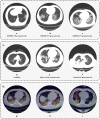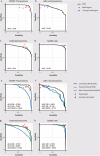This is a preprint.
A collaborative online AI engine for CT-based COVID-19 diagnosis
- PMID: 32511484
- PMCID: PMC7273252
- DOI: 10.1101/2020.05.10.20096073
A collaborative online AI engine for CT-based COVID-19 diagnosis
Abstract
Artificial intelligence can potentially provide a substantial role in streamlining chest computed tomography (CT) diagnosis of COVID-19 patients. However, several critical hurdles have impeded the development of robust AI model, which include deficiency, isolation, and heterogeneity of CT data generated from diverse institutions. These bring about lack of generalization of AI model and therefore prevent it from applications in clinical practices. To overcome this, we proposed a federated learning-based Unified CT-COVID AI Diagnostic Initiative (UCADI, http://www.ai-ct-covid.team/), a decentralized architecture where the AI model is distributed to and executed at each host institution with the data sources or client ends for training and inferencing without sharing individual patient data. Specifically, we firstly developed an initial AI CT model based on data collected from three Tongji hospitals in Wuhan. After model evaluation, we found that the initial model can identify COVID from Tongji CT test data at near radiologist-level (97.5% sensitivity) but performed worse when it was tested on COVID cases from Wuhan Union Hospital (72% sensitivity), indicating a lack of model generalization. Next, we used the publicly available UCADI framework to build a federated model which integrated COVID CT cases from the Tongji hospitals and Wuhan Union hospital (WU) without transferring the WU data. The federated model not only performed similarly on Tongji test data but improved the detection sensitivity (98%) on WU test cases. The UCADI framework will allow participants worldwide to use and contribute to the model, to deliver a real-world, globally built and validated clinic CT-COVID AI tool. This effort directly supports the United Nations Sustainable Development Goals' number 3, Good Health and Well-Being, and allows sharing and transferring of knowledge to fight this devastating disease around the world.
Conflict of interest statement
Competing interests The authors declare no competing interests.
Figures




References
Publication types
Grants and funding
LinkOut - more resources
Full Text Sources
